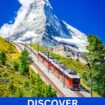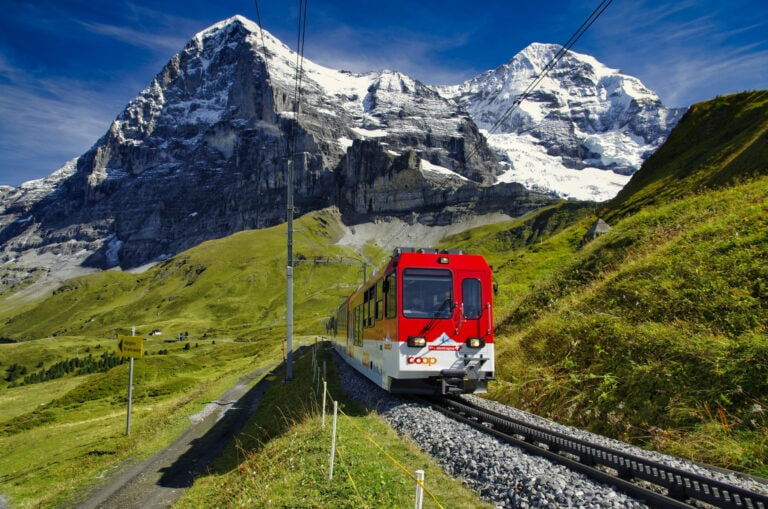
I would have complained if I were one of the settlers in Switzerland during the Roman Empire. I would have grumbled that this unconquerable territory was nothing but narrow valleys and cold, unforgiving mountains.
The Alps, with an average altitude of 5,576 feet, cover 2/3 of Switzerland. However, being the fierce fighters that they were, the Romans took all that in stride and used the mountains as fortresses.
Happy Alpine Cows
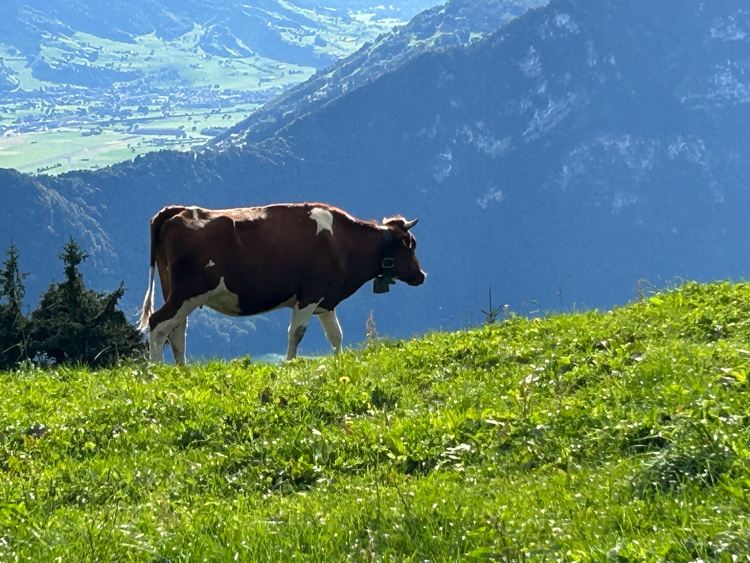
Then they needed to settle the area, and the inspiration they had was to cultivate the valleys and graze cows in the mountains. That worked. Now this country, ½ the size of New Jersey with 9M people, has 60 different types of cows that forage from May to September in the high altitudes.
The cows move to the lower elevations when the snow flies, and the multimillion-dollar production of cheese and chocolates is already underway. Perfect solutions, but those mountains are still unnavigable–or they would have been if the clever Swiss hadn’t devised plans to traverse them.
They laid multitudinous miles of train tracks, laid cog wheel tracks where the mountains were too steep for trains and bored holes when the passes were inaccessible.
Seeing Switzerland by Train is Efficient and Beautiful

The result is an efficient train system that penetrates mountains and delivers inhabitants to the most remote areas. The Swiss built the longest tunnel in the world, the Gotthard Tunnel, at 35 miles long. They established tourism with hiking trails and cable car systems that deliver skiers and hikers to stunning slopes.
One gondola, the Titlis Glacier Mountain Rotair near Lucerne, rotates 360 degrees. The Swiss have figured Switzerland it out and in fine style.
The undulating emerald hillsides glisten in sunshine, glaciers feed dusty turquoise rivers and mountain flowers burst from ruby red to daisy white. My beau and I traveled in summer and the weather was in the high 60s and low 70s. Who could ask for more when winding our way through Switzerland by train?
We arrived at Zurich, and then circled Switzerland by train, boat and bus: the Swiss way. Coordinated to arrive when trains did, buses and boats were a short walk away.
Part of Switzerland’s charm is that it enjoys many cultures in one country. The prevailing language is German since Germany borders part of Switzerland.
But also perched on the Swiss borders are Austria, France and Italy. This means that when you’re in Switzerland’s adjoining cities, the prevailing language changes, and you immerse yourself in those countries’ ethnicities.
Lucerne

When taking the train from Zurich to Lucerne, sit on the left side on the 2nd level for a view of three lakes. In Lucerne, you’ll speak German along with 2/3 of the population of Switzerland.
We stayed at Hotel Waldstatterhof, a quick walk from the train station. All our hotels were within walking distance of the trains.
Our first foray was to the Swiss Transport Museum. Out front was its immense drilling wheel used for the Gotthard Tunnel.
The museum served a lunch of their classic, Alpermagronen, Swiss mac and cheese. Caramelized onions and crispy bacon lardons top it, potatoes swim with pasta in the sauce and applesauce accompanies it.
For dinner, we had Zürcher Geschnetzeltes, spaetzle noodles with veal in a cream sauce, another scrumptious dish. An even better sauce accompanied Vol-au-vent stuffed with meatballs when we dined at La Barca on the Bahnhofstrasse riverfront.
The riverfront features the long, wooden Chapel Bridge with crimson flowers trailing down both sides. This structure crosses the River Reuss to the Chapel built in 1363.
The adjacent tower has served as an archive, treasury, prison and torture chamber. Today, it’s an intriguing structure soaring skyward.
Chalet-Studded Mountains

As we ventured into the mountains, we couldn’t get enough of the chalets, clustered among pine trees on the verdant hillsides and bedecked in flower boxes overflowing with ruby-red geraniums.
Some houses were built of wood. Others were a combination of stucco and wood, two-and-a-half stories high with wide eaves supported by decorative brackets. The uniformity of chalet-style houses (required in some zones) characterized Switzerland for me.
The abundance of waterfalls created a panorama that we feasted on. We departed from Lucerne on a cogwheel train for Mt. Rigi, which affords views of 620 Alpine peaks and 13 lakes.
We then took the boat cruise from Vitznau back to Lucerne and viewed the Lion Monument, carved in sandstone to commemorate Swiss soldiers who died during the French Revolution.
Interlaken
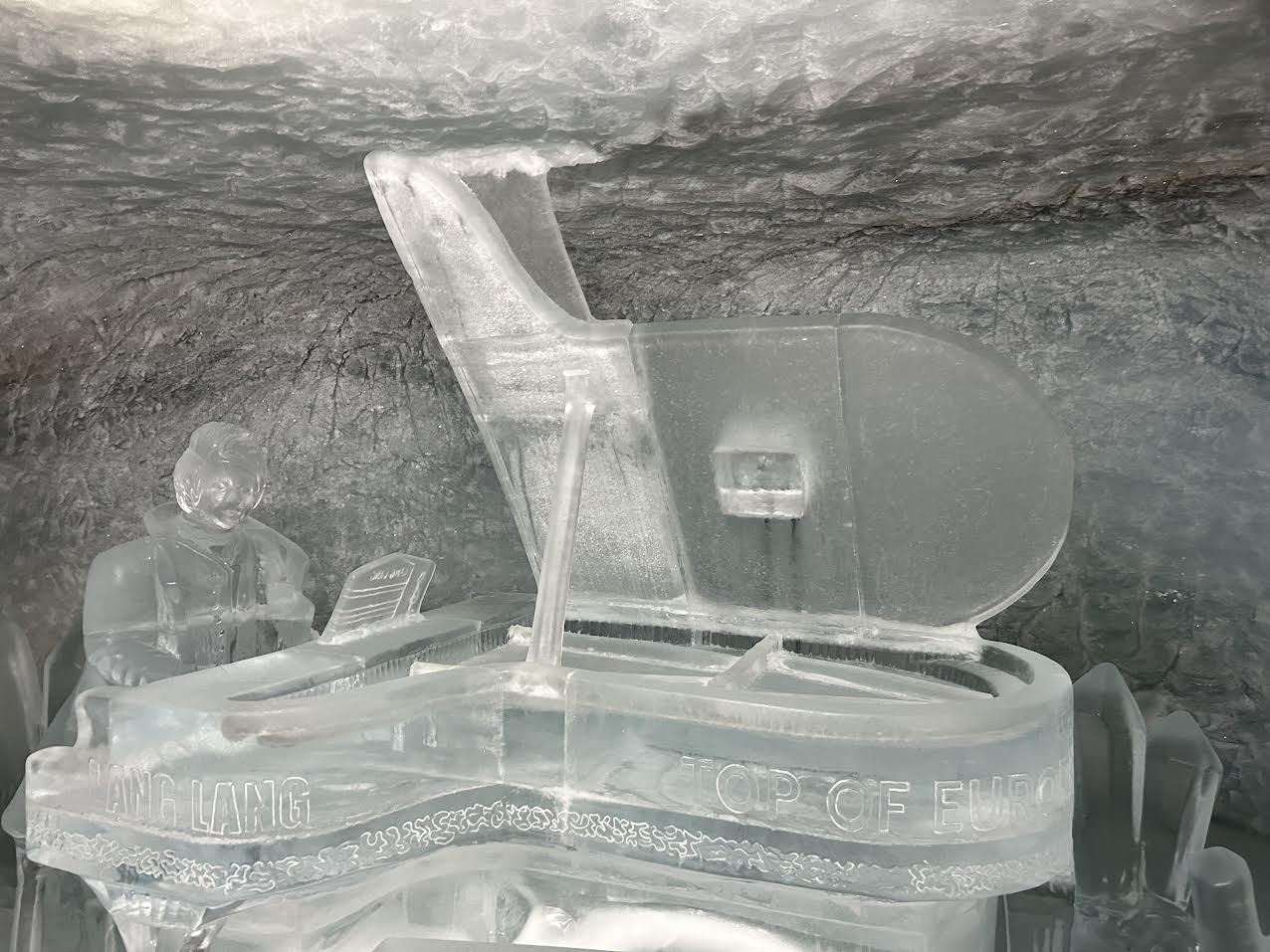
Leaving Lucerne, the Golden Pass Express zoomed us over the Brunig Pass in a breathtaking approach to Interlaken. There we ferried on Lake Brienz‘s “Jungfrau,” boat, splashed with Eidelweiss murals, to Grindelwald from which we viewed three stunning mountains, the Eiger, Mönch, and Jungfrau.
The schoolhouse-turned-museum in Grindenwald lent us a historical perspective, and then we made the very Swiss choice of fondue for lunch at Eiger Restaurant.
We climbed to Jungfrau Mountain, where we walked on Aletsch Glacier, feeling like walking on top of the world. The Jungfrau’s Ice Palace mesmerized (and nearly froze) me.
Travelers stroll among grottos that feature shimmering works of art, including ice sculptures of eagles, penguins and pianists playing at their pianos.
Bern

Our next excursion was to Bern, where the whole city is a UNESCO site. I was captivated by its fountains and 13th-century sandstone buildings lining the cobblestone streets.
After visiting artist Paul Klee’s Museum and Einstein’s home, we had lunch at the Manor department store, where we dined with a view from the open-air top floor.
Montreux

Chalets were becoming less frequent as our train whisked us from Bern through the resort town of Gstaad. Change was afoot. We needed to say auf wiedersehen to the German language and bonjour to French as we approached the French-dominated area.
Called the “Swiss Riviera” because of its balmy climate, Montreux boasts palm trees and vineyards as it nestles in the Rhone Valley. We had to dip our toes into Lake Geneva while there.
Brig
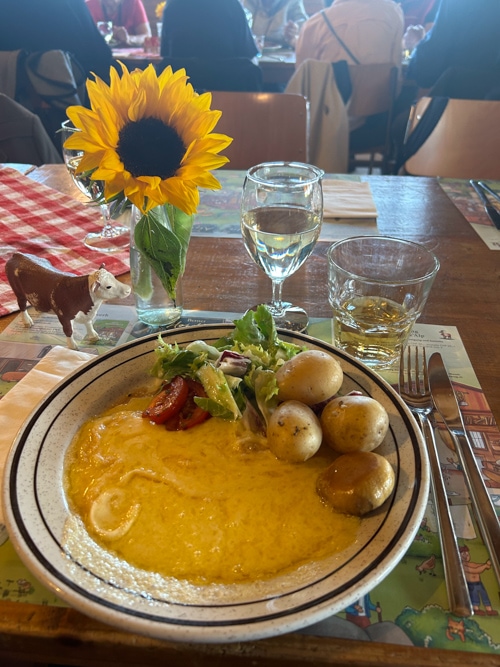
Photo by Marcia McGreevy Lewis
The Golden Pass Panoramic train delivered us to Brig, which claims to have invented Cordon Bleu, so we tried it at Restaurant zum Eigenossen. Too dry. A far superior meal was at Site Alp Cheese Factory, where we had raclette cheese into which we immersed potatoes, pickles, onions and mushrooms.
The cowbells clanked through lunch at this 5,000-foot-high factory as the cows roamed the hillside and we sipped Rivella, a drink made from whey.
Zermatt
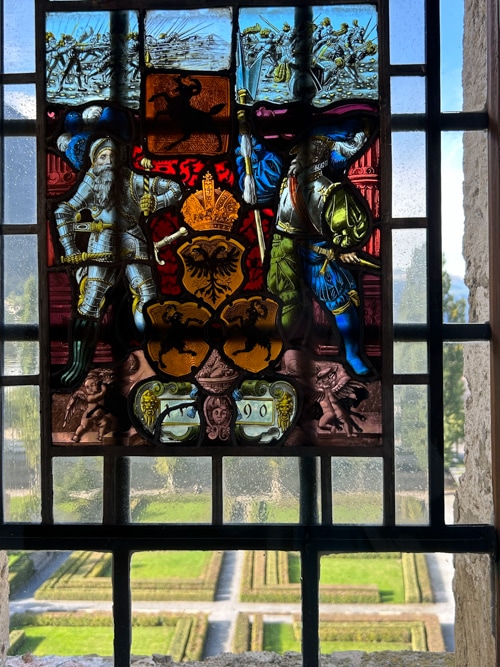
Our next tour was to rambling Stockalper Castle, a baroque palace built between 1658 and 1678 and in good repair. Then we boarded the train to Zermatt.
Lunch at Café Fuchs was cholera, a flaky potato and cheese pie. Delectable, despite its name. Then our train delivered us to the Matterhorn.
The day was clear, giving us truly a “peak” experience. We stared in awe at the pyramidal peak of this mountain that straddles the border between Italy and Switzerland.
Locarno

Image by MichalLudwiczak from Getty Images Signature via Canva
We said au revoir to French and ciao to Italian as we approached Bellinzona on our way to Locarno. Of course, we had gnocchi for lunch at Internazionale before touring the colossal Castle Grande, another UNESCO site. It was originally three medieval castles sitting within fortified walls.
Soon we wound our way to Locarno, where we observed the change in housing styles. No more art deco, which characterized the area around Montreux. The stucco houses in Lucarno oozed Italian heritage with their tile roofs, arched doorways and iron-railed balconies. Fig and olive trees completed the scene.
Lago Maggiore’s Hotel Geranio welcomed us in Locarno, and we were soon off to see Castello Visconteo, a castle built by Celts in the 4th century BC and now an archaeological museum.
Other sites of note were the Madonna del Sasso Sanctuary via the funicular, Brissago Island’s Botanical Garden and a visit to the neighboring city of Ascona.
Sonogno

We passed the nearly deserted town of Corippo on our train ride north to the ancient village of Sonogno. There, we learned that this isolated city survived on its Chestnut trees and by sending its boys to cities to become chimney sweepers until the 1970s.
It now subsists on Chestnut tree products like chestnut pureé used in crepes, hot roasted chestnuts and the freshly-made cheese we had for lunch at Alpino after a tour of the small Museum of Valle Verzasca.
St. Moritz

Arrivederci now to Italian as we head to St. Moritz, and baingvengi (welcome) to Romansh, the language in the canton of Grisons in which lies St. Moritz. Cantons are like our states. Stone houses with slate roofs give way to Italian villas, and larch trees replace the palms.
We checked into Hotel Soldanella and then had the treat of lunch in the refined dining car as we left by train to Poschiavo. Gloved waiters served us chicken stroganoff on warmed plates. The wooden interior walls were probably pine, and they warmed us too.
While Poschiavo is another beguiling, antiquated city, St. Moritz is a sophisticated resort town that resists putting price tags on items in its upscale stores.
You can imbibe the culture by visiting the Leaning Tower, a landmark dating back to the 12th century that was part of the old Church of St. Mauritius, destroyed in 1893. The Berry Museum, which houses artist Peter Robert Berry’s work, is another option.
We wrapped up our trip with a stay at Kloten’s Welcome Inn near the Zurich airport. I already miss schnitzel (breaded meat pounded thin with a meat tenderizer) spaetzle (fried egg noodles) and vermicelli-chestnut purée squiggles over meringue for dessert.
I also miss the crisp mountain air, the wild mountain flowers and the clinking of cowbells. The Romans never envisioned swirling past majestic glaciers on a train, but if they were with us today, they would have gasped out loud at the views.
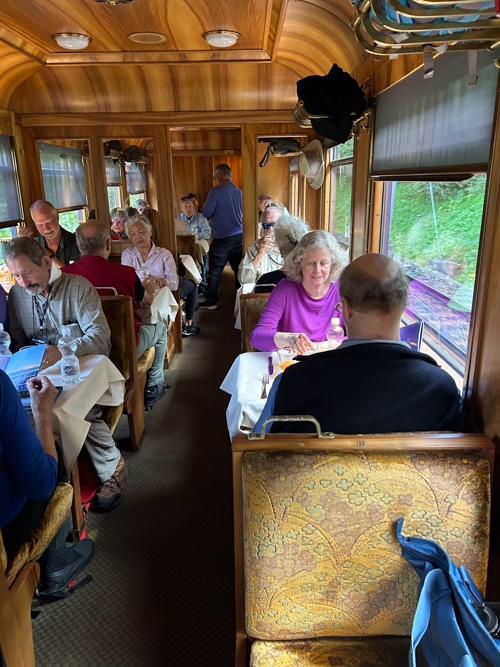
Photo by Marcia McGreevy Lewis
Where to Stay in Switzerland
Lucerne: Hotel Waldstatterhof
Interlaken: Hotel Artos
Brig: Schlosshotel
Locarno: Hotel Geranio
St. Moritz: Hotel Soldanella
Where to Eat in Switzerland
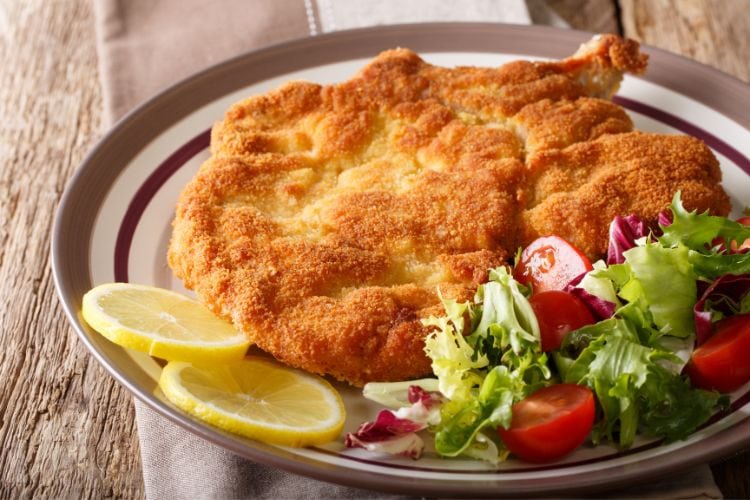
Lucerne: La Barca, Restaurant Lucide, Rathaus Brauerei, Restaurant William Tell (Swiss food)
Grindenwald: Eiger
Brig: Du Pont, Restaurant zum Eigenossen, Schlosskeller in Stockalper Castle
Bern: Manor, Lorenzo, Schwellenmatteli, Rose Garden
Zermatt: Café Fuchs
Bellinzona: Internazionale
Locarno: Lago Maggiore Bar & Lounge
Sonogno: Alpino
Kloten: Ristorante Mercato
What to See in Switzerland

Lucerne: Chapel Bridge, Swiss Transport Museum, Titlis Glacier Mountain Rotair,
Interlaken: Jungfrau
Bern: Museum of Fine Arts, Zentrum Paul Klee, Einstein Museum, Einstein Haus, Natural History Museum
Brig: Matterhorn
Lucarno: Castello Visconteo, Madonna del Sasso Sanctuary, Roman Bridge, visit Ascona, and Brissago Island’s Botanical Garden
St. Moritz: Berry Museum, Leaning Tower
Best Switzerland Tours and Excursions
If You Go:
On the 1st of March in St. Moritz, there is the Chalandamarz procession to chase away wintertime. In the mountains, there are parades when bringing the cows down from the mountains. Basel and Lucerne have Carnivals
Opt for Swiss francs when noting the exchange on your credit card purchases. Better rate.
The Train Travel Pass is worth it. It’s affordable and includes museums.
Inspire your next adventure with our articles below:
Author Bio: Marcia McGreevy Lewis, a retired feature writer for a Washington newspaper, writes for journals, magazines, travel sites and books. Reach her on Facebook and Instagram: marcialewis25, Twitter: @McGreevyLewis and Linkedin: marcia-lewis
Want to discover more hidden gems and helpful travel tips? Join our free newsletter for the latest travel secrets and travel articles.
We are reader-supported and may earn a commission on purchases made through links in this article.

